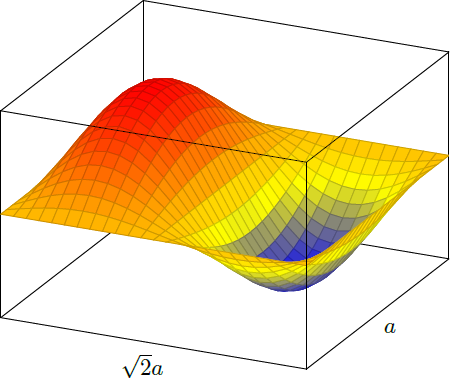Electrons in a box

Five electrons are in a two-dimensional potential well in the form of a rectangular box with side lengths and .
How large is their ground state energy?
Give the solution in units of , where is Planck's constant and denotes the electron mass.
We assume that the electrons do not interact with each other and that the potential well has infinitely high walls.
The answer is 13.5.
This section requires Javascript.
You are seeing this because something didn't load right. We suggest you, (a) try
refreshing the page, (b) enabling javascript if it is disabled on your browser and,
finally, (c)
loading the
non-javascript version of this page
. We're sorry about the hassle.
Relevant wiki: Schrödinger Equation
The energy eigenvalues of the electrons in the rectangular box are E n , l = 8 m h ( a 2 n 2 + b 2 l 2 ) = ε ( n 2 + 2 l 2 ) where n , l ∈ N ∖ { 0 } are quantum numbers. The lowest energy values are ( n , l ) E n , l / ε ( 1 , 1 ) 1 . 5 ( 1 , 2 ) 3 ( 2 , 1 ) 4 . 5 ( 1 , 3 ) 5 . 5 ( 2 , 2 ) 6 ( 2 , 3 ) 8 . 5 ( 1 , 4 ) 9 ( 3 , 1 ) 9 . 5 Since the electron is a spin- 2 1 -particle, a maximum of two electrons can be in the same state if they have different spin (Pauli principle). The ground state is thus obtained by filling the energy levels from below with electrons
Thus, the ground state energy results to E g = 2 E ( 1 , 1 ) + 2 E ( 1 , 2 ) + E ( 2 , 1 ) = 1 3 . 5 ⋅ ε
In the following I show a derivation of the eigenenergies of the potential box from the Schrödinger equation.
The wave function ψ ( x , y ) of the electrons for the eigenstates results as a solution of the time-independent Schrödinger equation − 2 m ℏ 2 ( ∂ x 2 ∂ 2 ψ ( x , y ) + ∂ y 2 ∂ 2 ψ ( x , y ) ) + V ( x , y ) ψ ( x , y ) where V ( x , y ) = { 0 ∞ 0 < x < a and 0 < y < b elsewhere = E ψ ( x , y ) For the left side of the equation to be finite, outside the box ψ ( x , y ) = 0 applies. Therefore, we only have to consider only the region inside the box where V ( x , y ) = 0 holds. So we can omit the term V ( x , y ) ψ ( x , y ) in the equation if we only use solutions with the boundary condition ψ ( 0 , y ) = ψ ( a , y ) = ψ ( x , 0 ) = ψ ( x , b ) = 0 . In addition, we take a separation approach ψ ( x , y ) = ϕ ( x ) χ ( y ) and solve the partial differential equation by separating the variables: ⇒ ⇒ − 2 m ℏ 2 ( ϕ ′ ′ ( x ) χ ( y ) + ϕ ( x ) χ ′ ′ ( y ) ) − 2 m ℏ 2 ( ϕ ( x ) ϕ ′ ′ ( x ) + χ ( y ) χ ′ ′ ( y ) ) ϕ ( x ) ϕ ′ ′ ( x ) = const , χ ( y ) χ ′ ′ ( y ) = E ϕ ( x ) χ ( y ) = E = const = const Thus, we obtain two ordinary differential equations for ϕ ( x ) and χ ( y ) with the boundary conditions ϕ ( 0 ) = ϕ ( a ) = 0 and χ ( 0 ) = χ ( b ) = 0 , with are solved by two sine functions with the corresponding period: ϕ ( x ) χ ( y ) = ϕ n ( x ) = sin ( a n π x ) , = χ l ( x ) = sin ( b l π x ) , where n where l = 1 , 2 , 3 , … = 1 , 2 , 3 , … The state ψ ( x , y ) of a single particle is thus described by two quantum numbers n and l and corresponds to an energy value E n , l = − 2 m ℏ 2 ( ϕ n ( x ) ϕ n ′ ′ ( x ) + χ l ( y ) χ l ′ ′ ( y ) ) = 2 m π 2 ℏ 2 ( a 2 n 2 + b 2 l 2 )